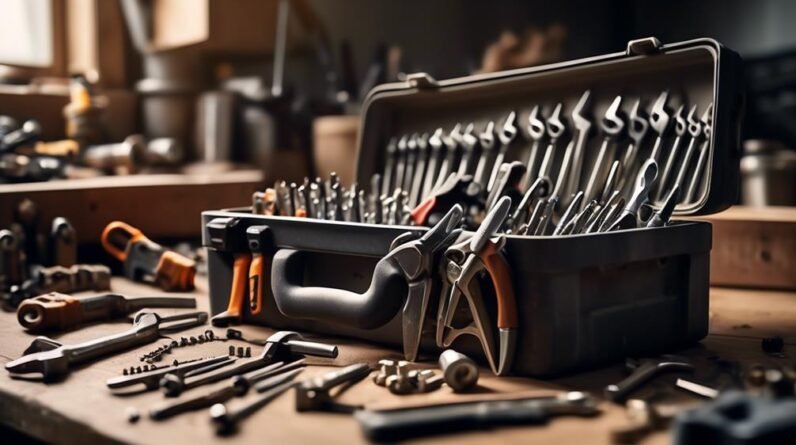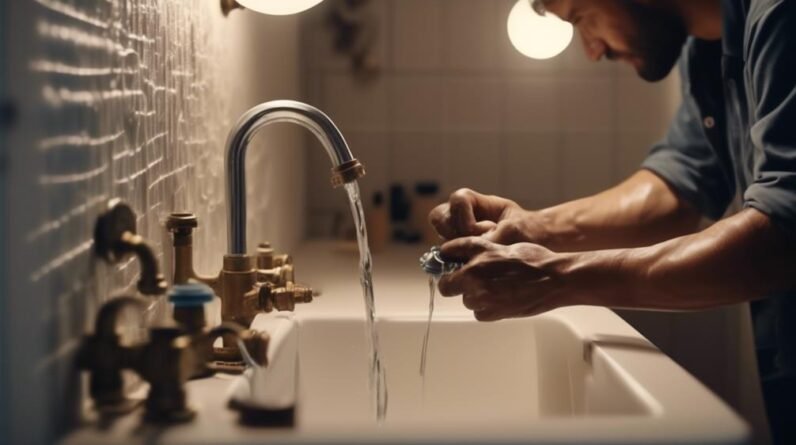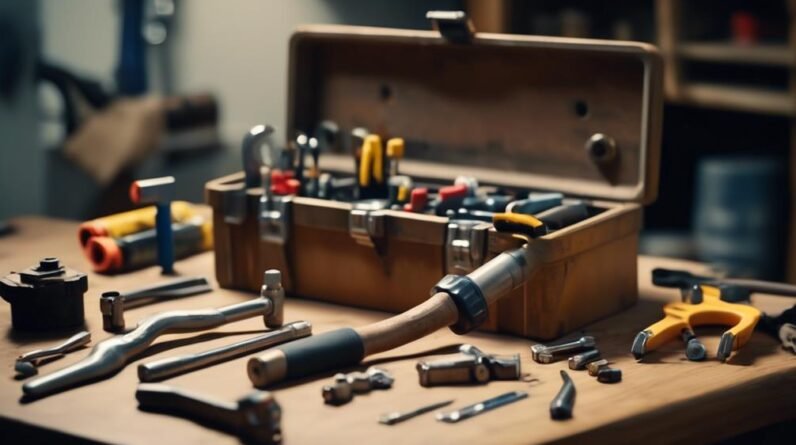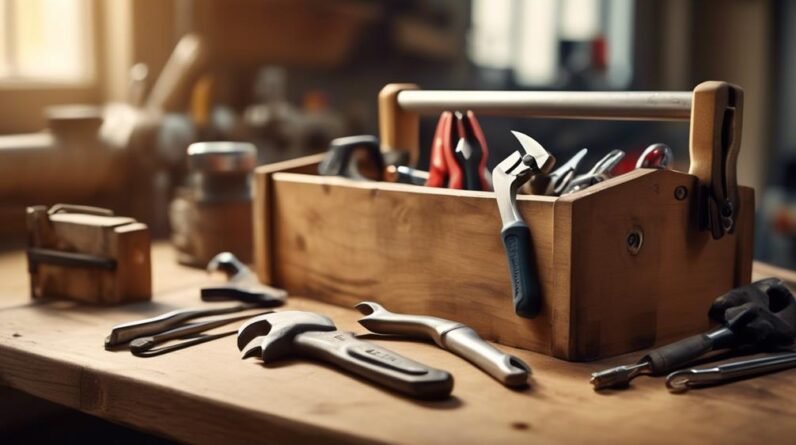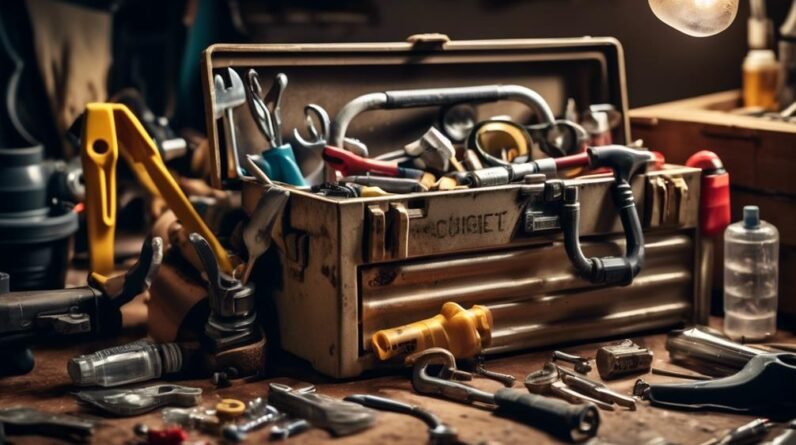
Do you find yourself constantly spending money on repairs and maintenance around your home? Well, fret no more! In this discussion, we will explore five fabulous and frugal cost-saving DIY techniques that will help you keep your hard-earned cash in your pocket where it belongs. From fixing leaky faucets to maintaining your car battery, we've got you covered. So, get ready to take charge of your household expenses and discover practical tips that will leave you wondering why you didn't try these sooner.
Key Takeaways
- Regularly check and fix leaky faucets to save on water bills and prevent further damage.
- Properly maintain your car battery to extend its lifespan and avoid unexpected breakdowns.
- Regularly clean and unclog gutters to prevent water damage to your home's exterior.
- Improve energy efficiency by insulating windows and doors, reducing heating and cooling costs.
Fixing Leaky Faucets
To fix a leaky faucet, you can easily follow these simple steps. First, check if the leak is coming from the shower head or the toilet flush. If it's the shower head, you may need to replace it. Start by turning off the water supply to the shower. Use a wrench to unscrew the old shower head from the pipe. Apply plumber's tape to the threads of the pipe to ensure a tight seal. Then, screw on the new shower head and tighten it with the wrench. Turn the water supply back on and check for any leaks. If the leak is from the toilet flush, the problem may be with the flapper valve or the fill valve. Start by turning off the water supply to the toilet. Remove the tank lid and inspect the flapper valve. If it's worn or damaged, replace it. If the fill valve is causing the leak, adjust the water level or replace the entire valve. Turn the water supply back on and check for any leaks. By following these steps, you can easily fix a leaky faucet and save yourself from wasting water and money.
Maintaining Your Car Battery
If you want to continue saving money and tackling DIY maintenance projects, it's important to also focus on maintaining your car battery. By extending the life of your battery and troubleshooting common issues, you can avoid unnecessary expenses and keep your car running smoothly. Here are a few techniques to help you maintain your car battery:
- Keep it clean: Regularly check your battery for dirt, corrosion, and loose connections. Use a mixture of baking soda and water to clean any buildup and ensure a good connection.
- Check the fluid level: Some batteries require topping up with distilled water. Check the fluid level regularly and add water if necessary, making sure not to overfill.
- Test the voltage: Use a multimeter to measure the voltage of your battery. A reading below 12.4 volts indicates a low charge and may require recharging or replacement.
- Avoid draining the battery: Leaving your headlights or interior lights on can quickly drain the battery. Be sure to turn off all electrical components when the engine is not running.
- Use a battery maintainer: If you don't use your car regularly, consider investing in a battery maintainer or trickle charger. This device will keep your battery charged and extend its overall lifespan.
Cleaning and Unclogging Gutters
Regular gutter maintenance is essential for preventing clogs and ensuring proper water drainage from your roof. Neglecting to clean and unclog your gutters can lead to a range of issues, including water damage to your home's foundation, roof leaks, and even pest infestations. To prevent gutter damage and keep your gutters functioning optimally, here are some important gutter maintenance tips to follow.
First, it is crucial to clean your gutters at least twice a year, preferably in the spring and fall. Remove any leaves, twigs, and debris that may have accumulated in the gutters to prevent clogs. Use a sturdy ladder and gloves to protect your hands while scooping out the debris. If the debris is too difficult to remove by hand, you can use a small garden trowel or a gutter scoop.
In addition to regular cleaning, it is also important to check for any leaks or damage to your gutters. Look for signs of rust, loose fittings, or sagging sections. If you spot any issues, repair them promptly to prevent further damage. You can use gutter sealant or replace damaged sections if necessary.
Insulating Windows and Doors
Insulate your windows and doors to improve energy efficiency and save on heating and cooling costs. Weatherproofing techniques are essential in preventing drafts and heat loss, keeping your home comfortable year-round. Here are some energy-saving tips to help you effectively insulate your windows and doors:
- Window insulation:
- Install weatherstripping: Use adhesive-backed weatherstripping to seal gaps between the window sash and frame. This will prevent air leakage and reduce energy loss.
- Apply window film: Insulating window film is an affordable option that adds an extra layer of insulation to your windows. It helps to block drafts and reduce heat transfer.
- Door insulation:
- Use door sweeps: Attach door sweeps to the bottom of exterior doors to seal the gap between the door and the threshold. This prevents cold air from entering and warm air from escaping.
- Install door insulation kits: These kits include foam tape and plastic film that you can apply to the interior of your doors. They provide an extra barrier against drafts and improve energy efficiency.
Repairing Cracked or Chipped Paint
To effectively repair cracked or chipped paint, follow these simple steps. First, start by inspecting the affected area. Look for any underlying issues such as repairing drywall cracks or patching up plaster walls. Once you have identified the cause, it's time to start the repair process.
Begin by cleaning the area around the crack or chip. Use a mild detergent and water solution to remove any dirt, dust, or grease. Let it dry completely before moving on to the next step.
Next, use a putty knife to apply a small amount of spackle or joint compound to the damaged area. Smooth it out evenly, making sure to fill in any gaps or holes. Allow it to dry according to the manufacturer's instructions.
Once the spackle or joint compound is dry, sand the area lightly using fine-grit sandpaper. This will help to create a smooth and seamless finish. Be careful not to sand too much and damage the surrounding paint.
After sanding, wipe away any dust with a damp cloth. Then, apply a primer to the repaired area. This will help the new paint adhere properly and ensure a long-lasting finish.
Frequently Asked Questions
How Can I Prevent Leaks in My Faucets in the First Place?
To prevent leaks in your faucets, practice regular plumbing maintenance techniques. Check for worn-out washers and seals, tighten any loose connections, and use pipe tape for a secure fit.
What Are Some Signs That My Car Battery Needs Maintenance?
If you're wondering about signs of a dying car battery, there are a few things to look out for. Dim headlights, difficulty starting your car, and a low battery warning light are all indicators that it may be time for a car battery replacement.
How Often Should I Clean and Unclog My Gutters?
How often should you clean and unclog your gutters? To clean gutters effectively and prevent clogs, it's recommended to do it at least twice a year, especially during spring and fall when debris is most likely to accumulate.
Can I Use Any Type of Insulation for Windows and Doors?
You can use various types of insulation for windows and doors. Proper insulation helps in reducing energy costs, minimizing drafts, and improving comfort. It's important to choose the right insulation option for maximum benefits.
Are There Any Specific Tools or Techniques I Should Use When Repairing Cracked or Chipped Paint?
To repair cracked or chipped paint, start by cleaning the area and removing loose paint. Then, use a putty knife to fill in the cracks or chips with spackling compound. Sand the area smooth and apply a fresh coat of paint.
Conclusion
In conclusion, by implementing these cost-saving DIY maintenance techniques, you can save money and time in the long run. Taking care of leaky faucets, maintaining your car battery, cleaning gutters, insulating windows and doors, and repairing cracked or chipped paint can all be easily done with a little effort and basic tools. So why not give it a try and enjoy the benefits of a well-maintained home and car while keeping your budget intact?


